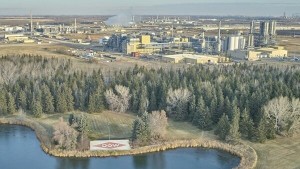From an Article by Amy Baxter, Energy Environment Leader, December 1, 2023
Dow has approved the final investment decision for its Fort Saskatchewan, Canada, Path2Zero investment.
The project is the first net zero Scope 1 and 2 emissions-integrated ethylene cracker and derivatives facility in Alberta, Canada. The project comes at a cost of $6.5 billion, excluding governmental incentives and subsidies, and covers building a new ethylene cracker and increasing polyethylene capacity by 2 million metric tonnes per year. The project will also retrofit the site’s existing cracker to net zero Scope 1 and 2 emissions.
Dow expects the investment to deliver $1 billion of earnings before interest, taxes, depreciation, and amortization growth at full run rates over the economic cycle while providing 20% decarbonization of Dow’s global ethylene capacity. Ethylene is used widely in the chemical industry.
Dow expects to begin construction on the project in 2024, with the first capacity phase expected in 2027, adding approximately 1,285 metric kilotons per year of ethylene and polyethylene capacity. The second phase starting up in 2029 will add approximately 600 metric kilotons per year of capacity.
“The opportunity to decarbonize our assets while driving growth is central to Dow’s business strategy,” said Jim Fitterling, Dow chair and CEO. “All our stakeholders benefit from this investment — creating value for our customers and shareholders, new opportunities for our employees, economic growth for the community, and fewer greenhouse gas emissions for the environment.”
Site to Aims for Net Zero Scope 1 and 2 Emissions
The Fort Saskatchewan Path2Zero project will deploy Linde’s air separation and autothermal reformer technology, which will convert the site’s cracker off-gas to hydrogen and achieve net zero Scope 1 and 2 emissions. Linde is a multinational chemical company.
The hydrogen can be used as a clean fuel that will supply the site’s furnaces. The project will also leverage carbon capture technology to store carbon emissions, reducing existing emissions by approximately 1 million metric tons a year of CO2.
According to Dow, when the project reaches full run rate it will be one of the company’s most cost-competitive sites in the world. Dow, which offers science-based products for plastics, coatings, and silicones businesses, operates manufacturing sites in 31 countries. The region of the project also offers access to existing carbon transportation and storage infrastructure with available capacity for the project.
Canada Offers Incentives for the Project
Dow received subsidies and incentives from the governments of Canada, Alberta, and Fort Saskatchewan to support the project, and it is the first project to access Canada’s new ITC program — a tax credit program for net-zero energy technologies and carbon capture and storage.
Dow will use roughly $2 billion of investment from third-party companies for circular hydrogen, CO2 capture, and other infrastructure assets as part of the project.
#######+++++++#######+++++++#######
Eyes on Shell ~ Beaver County Marcellus Awareness Community (BCMAC)
We are concerned residents monitoring the impacts of Shell’s cracker plant on our health and environment to keep our families safe.
Join Us, Report an Incident, Learn About Cracker Plants
All of us, no matter where we come from or what we look like, want to live in a safe, healthy environment where our families can thrive. But fossil fuel lobbyists and the politicians they pay for are once again sacrificing our health for their profits. We are coming together as a community to protect our families and hold Shell accountable for the damage caused to our environment.
You can be part of the Eyes on Shell watchdog team. If you see, smell, or hear something that doesn’t seem right, let us know.
Eyes on Shell meets virtually every month. Click the link here for more information and to register for the next meeting. (December & January sessions being substituted).
Cliff’s Corner, Zoom Sessions, Wednesdays, December 6th & January 3rd @ 7:30 PM

